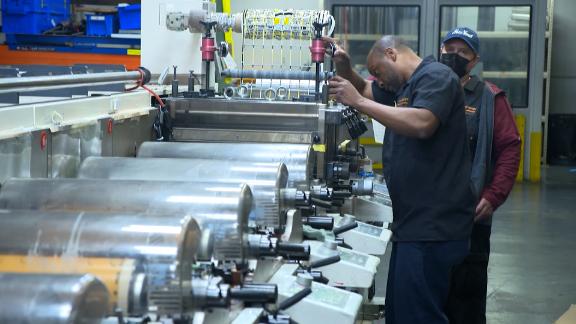
New York (CNN Business) – Investors are gearing up for a week of big ticket economic data, including a first look at economic growth between January and March and more inflation numbers.
America’s economic activity, measured by gross domestic product, is forecast to have only grown at an annualized pace of 1% in the first quarter of the year, according to consensus expectations from Refinitiv. The Federal Reserve Bank of Atlanta’s GDPNow model forecasts a seasonally adjusted annualized growth rate of 1.3% as of mid-April.
That would be a steep drop compared with the 6.9% growth pace in the final quarter of 2021 and would make it the worst three-month period since the pandemic recession in the second quarter of 2020.
Economists had predicted that growth would eventually slow down from the pace seen during the great reopening. But even compared with pre-pandemic times, when the US economy grew steadily at a more moderate pace, 1% would be disappointing.
So how did this happen?
For one, companies rebuilt their inventories in the final three months of last year, which boosted economic activity. But this petered out in the first quarter of 2022, according to economists from Action Economics.
The quarter also began with the Omicron wave of the coronavirus, surging infections and renewed restrictions aimed at containing the virus. While the effects were short-lived, the longer-term impact is only now becoming apparent.
Americans also had soaring prices to worry about, not to mention Russia’s invasion of Ukraine that sent gas prices through the roof. In March, retail sales data from the Census Bureau showed that overall sales were only boosted by spending at gas stations, where sales jumped nearly 9%.
It’s stressing an important point: So far, US consumers are still spending freely, but much of that appears down to ubiquitously higher prices rather than increased consumption. Even though Americans still have pent-up savings from the lockdown days of the pandemic, inflation levels not seen in 40 years don’t exactly make people go on extravagant shopping sprees. Eventually, this reality will catch up with US economic growth, which needs healthy consumer spending.
Forget the FAANGs. It’s a stock picker’s market now
Investors who have been blindly buying Big Tech stocks got a rude awakening last week after Netflix imploded. But the good news from Tesla proves that some top momentum stocks can still thrive in this rocky market.
The latest results from Tesla (TSLA) and Netflix (NFLX) show how silly it is for investors to buy into themes and memes like the FAANGs, or MT. FAANG, if you want to add Microsoft and Tesla to the quintet of Facebook, Amazon, Apple, Netflix and Google.
This is a stock picker’s market, my CNN Business colleague Paul R. La Monica reports.
“This environment will create an important backdrop for active investing,” said Ken McAtamney, head of William Blair’s global equity team, in a report.
One of the biggest mistakes that an investor can make is assuming that all stocks in a certain sector should rise and fall in tandem. That’s an overly simplistic, binary view of the world.
Instead, investors need to do their homework and find companies with strong business models and healthy fundamentals.
“Not all businesses are created equally,” said Paul Moroz, chief investment officer with Mawer Investment Management.
The Big Tech leaders of the Nasdaq are a broad and diverse group. That’s why investors shouldn’t assume that Netflix’s problems are bad for the rest of the tech sector, or that Tesla’s good news gives traders the all clear sign to buy every surging stock in sight.
“First quarter results so far highlight our view that investors need to be selective,” Mark Haefele, chief investment officer at UBS Global Wealth Management, said in a report last week.
Coming up: How will the other Big Tech names fare? This week’s earnings highlights include results from Apple, Amazon, Google, Facebook’s Meta and Microsoft.




